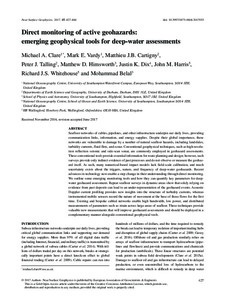| dc.contributor.author | Clare, Michael A. | |
| dc.contributor.author | Vardy, Mark E. | |
| dc.contributor.author | Cartigny, Matthieu J.B. | |
| dc.contributor.author | Talling, Peter J. | |
| dc.contributor.author | Himsworth, Matthew D. | |
| dc.contributor.author | Dix, Justin K. | |
| dc.contributor.author | Harris, John M. | |
| dc.contributor.author | Whitehouse, Richard J.S. | |
| dc.contributor.author | Belal, Mohammad | |
| dc.date.accessioned | 2020-04-11T20:26:33Z | |
| dc.date.available | 2020-04-11T20:26:33Z | |
| dc.date.issued | 2017 | |
| dc.identifier.citation | Clare, M.A. ; Vardy, M.E.; Cartigny, M.J.B.; Talling, P.J.; Himsworth, M.D.; Dix, J.K.; Harris, J.M.; Whitehouse, R.J.S. and Belal, M. (2017) Direct monitoring of active geohazards: emerging geophysical tools for deep-water assessments. Near Surface Geophysics, 15, pp.427-444. DOI: https://doi.org/10.3997/1873-0604.2017033 | en_US |
| dc.identifier.uri | http://hdl.handle.net/11329/1270 | |
| dc.identifier.uri | http://dx.doi.org/10.25607/OBP-785 | |
| dc.description.abstract | Seafloor networks of cables, pipelines, and other infrastructure underpin our daily lives, providing
communication links, information, and energy supplies. Despite their global importance, these
networks are vulnerable to damage by a number of natural seafloor hazards, including landslides,
turbidity currents, fluid flow, and scour. Conventional geophysical techniques, such as high-resolution
reflection seismic and side-scan sonar, are commonly employed in geohazard assessments.
These conventional tools provide essential information for route planning and design; however, such
surveys provide only indirect evidence of past processes and do not observe or measure the geohazard
itself. As such, many numerical-based impact models lack field-scale calibration, and much
uncertainty exists about the triggers, nature, and frequency of deep-water geohazards. Recent
advances in technology now enable a step change in their understanding through direct monitoring.
We outline some emerging monitoring tools and how they can quantify key parameters for deepwater
geohazard assessment. Repeat seafloor surveys in dynamic areas show that solely relying on
evidence from past deposits can lead to an under-representation of the geohazard events. Acoustic
Doppler current profiling provides new insights into the structure of turbidity currents, whereas
instrumented mobile sensors record the nature of movement at the base of those flows for the first
time. Existing and bespoke cabled networks enable high bandwidth, low power, and distributed
measurements of parameters such as strain across large areas of seafloor. These techniques provide
valuable new measurements that will improve geohazard assessments and should be deployed in a
complementary manner alongside conventional geophysical tools. | en_US |
| dc.language.iso | en | en_US |
| dc.rights | Attribution 4.0 International | * |
| dc.rights.uri | http://creativecommons.org/licenses/by/4.0/ | * |
| dc.title | Direct monitoring of active geohazards: emerging geophysical tools for deep-water assessments. | en_US |
| dc.type | Journal Contribution | en_US |
| dc.description.refereed | Refereed | en_US |
| dc.format.pagerange | pp.427-444 | en_US |
| dc.identifier.doi | 10.3997/1873-0604.2017033 | |
| dc.subject.parameterDiscipline | Parameter Discipline::Marine geology::Field geophysics | en_US |
| dc.bibliographicCitation.title | Near Surface Geophysics | en_US |
| dc.bibliographicCitation.volume | 15 | en_US |
| dc.description.sdg | 14.A | en_US |
| dc.description.bptype | Manual (incl. handbook, guide, cookbook etc) | en_US |
| obps.contact.contactemail | michael.clare@noc.ac.uk | |
| obps.resourceurl.publisher | https://onlinelibrary.wiley.com/doi/abs/10.3997/1873-0604.2017033 | en_US |
 Repository of community practices in Ocean Research, Applications and Data/Information Management
Repository of community practices in Ocean Research, Applications and Data/Information Management

